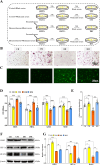Traditional Chinese medicine Youguiyin decoction ameliorate glucocorticoid-induced osteonecrosis in rat by modulating ROS/PHD2/HIF-1α oxidative stress signaling pathway in bone marrow mesenchymal stem cells
- PMID: 40319297
- PMCID: PMC12049805
- DOI: 10.1186/s13020-025-01113-1
Traditional Chinese medicine Youguiyin decoction ameliorate glucocorticoid-induced osteonecrosis in rat by modulating ROS/PHD2/HIF-1α oxidative stress signaling pathway in bone marrow mesenchymal stem cells
Abstract
Background: The incidence of osteonecrosis is increasing annually due to the widespread use of glucocorticoids. Recent evidence suggests a significant association between glucocorticoid-induced osteonecrosis and oxidative stress. Youguiyin (YGY) decoction, a classic formula of traditional Chinese medicine, has been widely used for the prevention of glucocorticoid-induced osteonecrosis. However, its underlying pharmacological mechanisms are still not fully understood.
Methods: UPLC-Q-TOF-MS and network pharmacology were used to elucidate the material basis of YGY decoction and its mechanism for the treatment of glucocorticoid-induced osteonecrosis. The anti-oxidative stress and bone-enhancing effects in vivo were detected by hematoxylin-eosin (HE) staining, serum metabolomics, enzyme-linked immunosorbent assay (ELISA), immunohistochemistry (IHC), and Western Blot (WB). Rat bone marrow mesenchymal stem cells (BMSCs) were induced with dexamethasone (DXMS) for 24 h, followed by YGY medicated serum for 24 h. Significantly up- and down-regulated genes were detected by RNA sequencing. Oxidative stress levels were detected by ROS fluorescence. Alizarin red S staining was used to detect osteogenic effects. WB and ELISA were used to detect the expression of proteins related to the ROS/PHD2/HIF-1a pathway.
Results: The application of YGY decoction significantly promoted bone repair and antagonized excess reactive oxygen species (ROS) generation in glucocorticoid-associated osteonecrosis of the femoral head (GA-ONFH) rats. In addition, YGY medicated serum antagonized DXMS-induced ROS production and promoted osteogenic differentiation in BMSCs. We also found that YGY medicated serum attenuated excess ROS generation while PHD2 expression was significantly increased, HIF-1α expression was significantly decreased and RUNX2 expression was significantly increased.
Conclusion: These results provide compelling in vivo and in vitro evidence that YGY decoction may play a role in promoting glucocorticoid-induced osteonecrosis bone repair by targeting the mediation of the ROS/PHD2/HIF-1α oxidative stress signaling pathway, thus providing a new theoretical basis for the clinical application of YGY decoction to glucocorticoid-induced osteonecrosis.
Keywords: Glucocorticoid-induced osteonecrosis; Oxidative stress; ROS/PHD2/HIF-1α pathway; Youguiyin (YGY) decoction.
© 2025. The Author(s).
Conflict of interest statement
Declarations. Ethics approval and consent to participate: All procedures were performed in accordance with the guidelines of the Affiliated Hospital of Nanjing University of Chinese Medicine ethics committee. Consent for publication: The manuscript is approved by all authors for publication. Competing interests: The authors declare that they have no competing interests.
Figures









References
-
- Zhao FC, Guo KJ, Li ZR. Osteonecrosis of the femoral head in SARS patients: seven years later. Eur J Orthop Surg Tr. 2013;23(6):671–7. - PubMed
-
- Ichiseki T, Kaneuji A, Ueda Y, Nakagawa S, Mikami T, Fukui K, Matsumoto T. Osteonecrosis development in a novel rat model characterized by a single application of oxidative stress. Arthritis Rheum. 2011;63(7):2138–41. - PubMed
Grants and funding
- 82474342/National Natural Science Foundation of China
- 2024-QNRC2-B18/China youth science and technology talent lifting project
- MS2023023/Science and Technology Development Programme Project of Jiangsu Provincial Administration of Traditional Chinese Medicine
- JSDW202252/Jiangsu Provincial Medical Key Discipline (Laboratory)
- JSTJ-2024-098/Jiangsu Province youth science and technology talent lifting project
LinkOut - more resources
Full Text Sources

